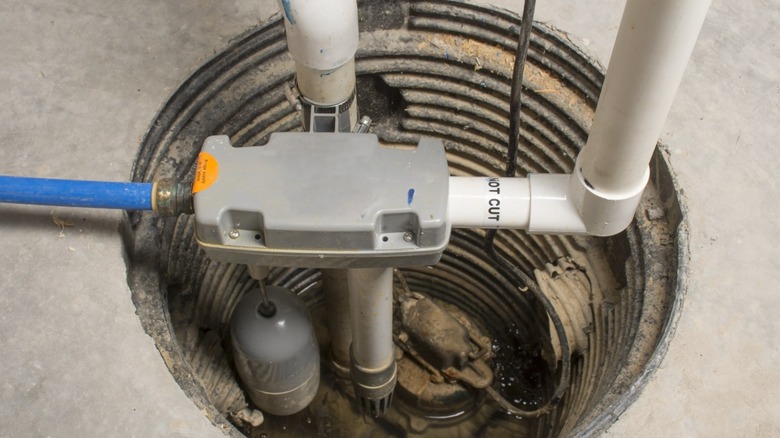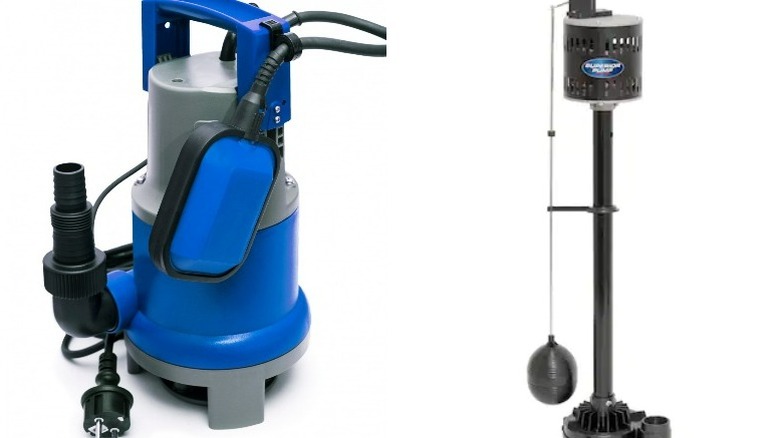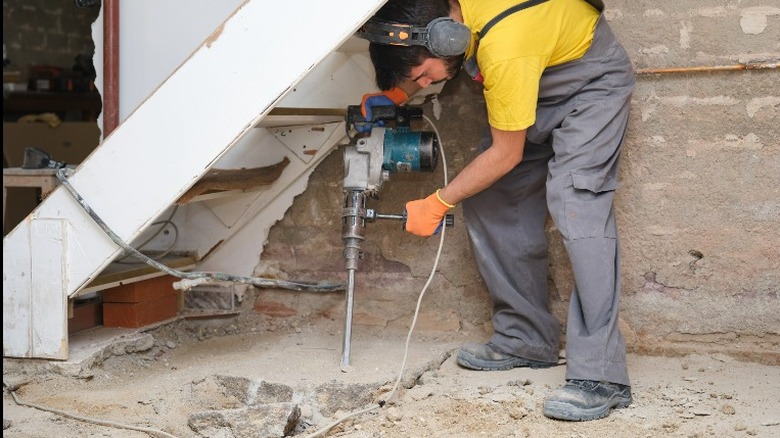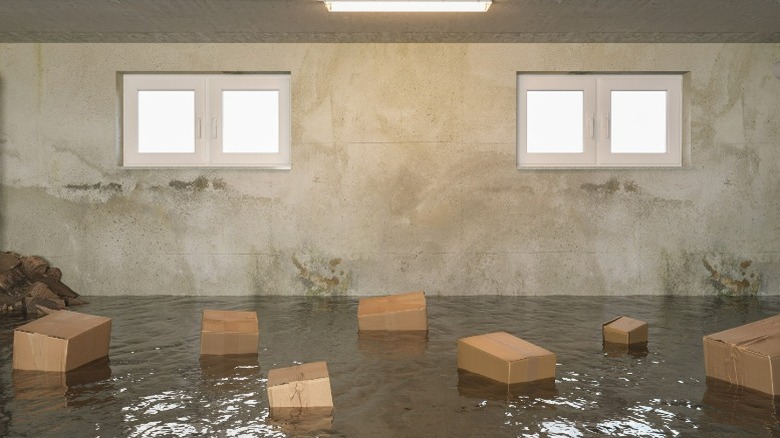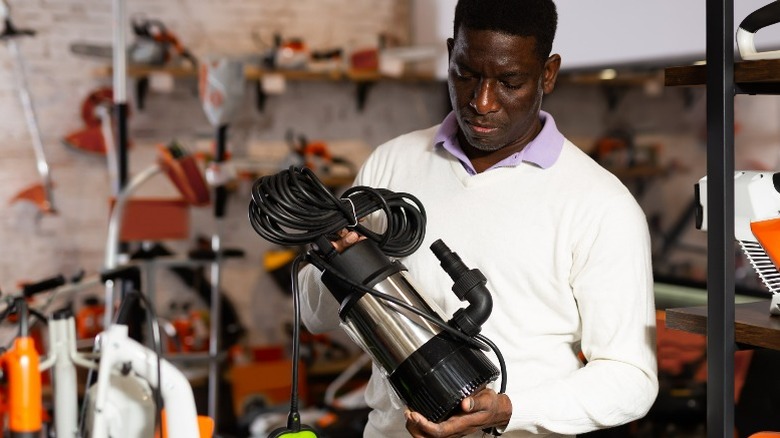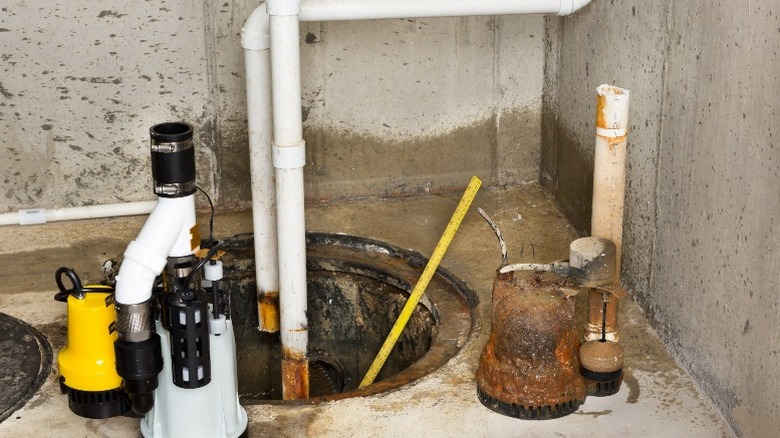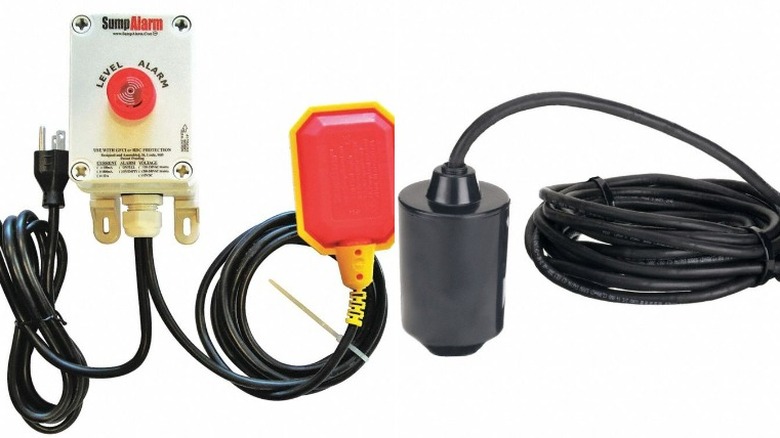Sump Pumps: What To Know Before You Buy
A flooded basement is a nightmare, whether you have a finished basement or just use it for storage. When your basement floods, it not only causes costly damage, but also destroys valuable and sentimental items, and leaves you with a huge mess to clean up. If you don't address things quickly, you may also have to deal with mold and mildew. In extreme flooding, the water can also damage your foundation. Sump pumps are one of those purchases that help prevent water damage. You never really think about them until you get water in your basement, but then, your sump pump becomes a lifesaver.
The purpose of a sump pump is to pump water out of your basement or crawl space and away from your house, says Fresh Water Systems. Water can enter a basement from heavy rainstorms, groundwater, the perimeter drains in a basement waterproofing system, or even a busted water pipe. A sump pump is basically a pump and a motor that sits in a sump basin, or a pit in the ground below the basement floor or below a crawl space. As the sump basin fills with water, a float-activated sensor is triggered and turns on the sump pump. The water is pumped up and out through a PVC pipe and drained away from your house.
Types of sump pumps
There are two types of sump pumps: submersible and pedestal. Submersible pumps are placed below the water at the bottom of the sump basin. The noise level is reduced because the pump and the motor are sealed in a waterproof container and operate underwater, writes This Old House. The water also helps to cool the motor, which is especially important during extended periods of use. Submersible pumps have greater horsepower making them more powerful than pedestal pumps. They can pump more gallons per hour and have the power to pump water further distances, up to ground level and out and away from your house. It's also able to pump out solids and small-sized debris that may find their way into your sump basin.
Pedestal pumps are not submersible. Real Seal explains that the motor is located above ground and connected to the pedestal base by a drive shaft. The pedestal stands at the bottom of the sump basin. Inside the pedestal is a rotor that spins around and sucks up the water in the sump basin and pumps it out through a designated pipe. Since the motor sits above ground, it is noisier than a submersible pump. Pedestal pumps cannot handle particles or solid materials that get into the sump basin. They have less horsepower so they cannot pump as many gallons per hour as a submersible pump and will not necessarily be able to pump the water the vertical and horizontal distance you need to drain the water outside and away from your house.
How are sump pumps installed?
If your basement does not already have a sump basin, you will need to hire someone who can use a jackhammer to break through the concrete floor. It's best to hire a sump pump specialist or someone with the expertise to do this. Once the concrete section is removed, a basin is dug in the ground below. A sump pump should be located in the lowest-lying area of your basement, so water naturally flows towards it, says NIR Home Inspections. If it's not properly placed, you could end up with standing water in your basement until the water level gets high enough to reach the basin.
The pump can be directly wired into a home's electrical system, or it can plug into an outlet located close to the pump. The outlet must be a dedicated circuit, and a Ground Fault Circuit Interrupter (GFCI) outlet to prevent electrical shock. Keep the pump's power cord out of the water, and not laying on the basement floor where it could get wet. If your basement floods, it's very important that you do not go downstairs until you turn off the electricity at the circuit breaker panel, advises This Old House. If your electrical panel is in the basement, call the power company and have them turn off all power to the house, either directly or remotely, at the meter. Blain's Farm & Fleet also recommends checking with your municipal Department of Public Works before installing a sump pump. You may need a permit, or have to check where your electrical lines and sewer lines are located below your house.
Choosing the right backup sump pump
Your primary electric pump only works until you lose electricity. There are two types of backup sump pumps, battery-powered or water-powered, says the Water Damage Defense team. They explain that the decision over which to use in your home is driven by your specific plumbing system setup, your water volume needs, and other preferences. Each backup has its advantages and disadvantages.
A battery backup pump can be quite powerful and uses the same discharge pipe as the primary pump, making installation straightforward. The disadvantage is that they can only operate for a few hours unless the battery is recharged. This may be enough for short power outages, but not for hours-long outages. The batteries have to be replaced every 3 to 5 years.
Water-powered pumps use municipal water pressure and have a potentially unlimited run time, as long as water is available. When the primary pump stops, the water in the sump pit lifts a float which immediately opens a valve. This allows the municipal water to create a suction that empties the sump pit and drains the water out of your house through a discharge pipe. If you love science, this video from Water Commander shows how it works. Unfortunately, these pumps can't be used if your home uses a well, because a power outage will shut off the well pump. Your home's plumbing system also has to meet certain criteria, and the installation is more involved since the pump connects to your home's water supply.
How much do sump pumps cost?
If a basement has a dirt floor, digging the sump pump pit will cost between $300 to $500, or $5 to $10 per linear foot, says Bob Vila. Complete sump pump installation in a concrete floor averages between $2,000 to $6,000, because jackhammers and other specialized equipment are required to break through the concrete. This cost also includes the pump and the drains. Installing a sump pump in a hard-to-reach area, like a crawl space where the plumbing may be complex and densely packed, can also increase the cost.
Once you have a sump pit, the average installation of a sump pump (not including the drains) runs about $250 to $600 for parts and labor, depending on the quality of the equipment, ease of access and local labor rates, says Cost Helper. A pedestal pump costs approximately $60 to $170, while a submersible pump costs between $100 and $400. Labor can run between $45 and $200 per hour for installation, depending on your geographic location. Submersible pumps take longer to install and will cost more in labor. Sump pump replacement is less expensive than installing one for the first time. The labor to replace an existing sump pump with a similar model runs around $50-$150.
A battery-operated backup pump is roughly $150 to $350, with cost depending on horsepower, flow rate, materials and other features. Water-powered backup pumps may cost up to $350, not including labor. The more features, functionality and gallons per hour of drainage, the higher the cost.
What is the life expectancy of sump pumps?
The U.S. Department of Housing estimates that a sump pump runs for about an average of 10 years, reports the Sump Pump Problem team. It should be noted, however, that the number varies widely depending on the pump and the conditions it's subjected to. Aquamaster Plumbing says that submersible pumps have a life expectancy of 15 years and pedestal pumps of 25 years. There are several factors that impact the pump's longevity. For example, a pump that is too small has to work harder if the volume of water is too great, and over time that may strain or burn out the motor. The frequency of usage also reduces longevity.
Regular maintenance can prolong the life span of a sump pump. To clean your pumping system, disconnect it from the battery or electricity before you pull the pump completely out of the sump pit. Now you'll have enough space to clean the drainage grates and make sure the output areas are free from obstructions. Another helpful tip is to test the pump from time to time by adding water to the sump pit to make sure that your pump will work when you need it.
Additional features to consider
There are a number of additional features to consider before you settle on which sump pump to buy. Sump pump alarms alert you to dangerous water levels before it becomes a problem, says R.C. Worst & Company. A basic alarm has a float located in the sump pump basin. When the water reaches the float it triggers the alarm control box. An alarm will sound and a visual indicator will light up. Some alarms will send an email or text. The price of a basic alarm starts at $13. Alarms that send email alerts can cost about $250, some have annual fees. A round-up and comparison of sump pump alarms can be found on the CFC company website.
You should also pay attention to horsepower. A sump pump's horsepower (HP) refers to its overall power, explains This Old House. A higher HP motor is able to pump more water per hour than a lower HP motor. and is typically more expensive. Most sump pumps have either a digital or manual switch to start their motors. Manual models contain floats that rise with the floodwater, turning the pump on automatically when the water reaches a certain level. When the floats dip below the set level, the pump stops. Other models feature digital on-and-off sensors. When the water rises to meet the "on" sensor, the pump starts working. When the water lowers and reaches the "off" sensor, the pump turns off. Another factor to consider is material. Sump pumps are usually made of plastic or some sort of metal, such as aluminum, stainless, steel, or cast iron. Plastic sump pumps are more affordable, but they're not as durable as metal sump pumps. If the options feel overwhelming, you can always consult with a sump pump installer or a plumber to find the best solution for your home.
